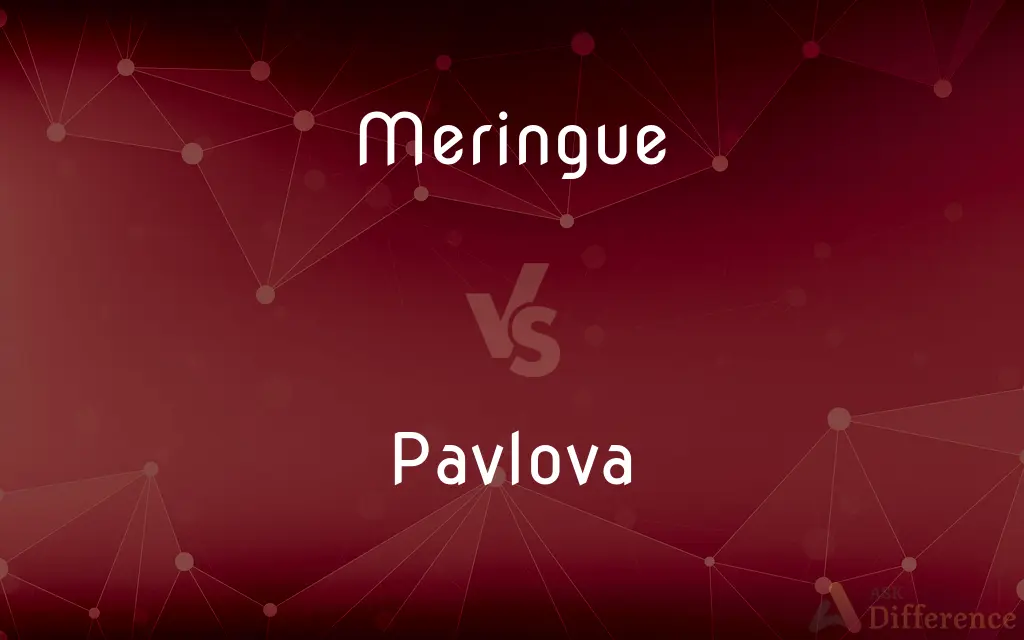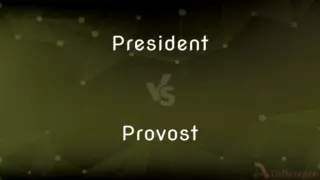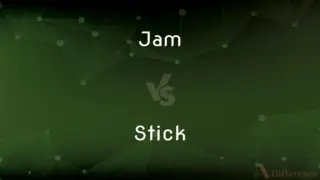Meringue vs. Pavlova — What's the Difference?
By Fiza Rafique & Maham Liaqat — Updated on April 5, 2024
Meringue is a light, airy dessert made from whipped egg whites and sugar, while Pavlova is a meringue-based dessert topped with whipped cream and fruit, distinguished by its crispy crust and soft, marshmallow-like interior.

Difference Between Meringue and Pavlova
Table of Contents
ADVERTISEMENT
Key Differences
Meringue serves as both a dessert on its own and a component in various pastries, characterized by its glossy appearance and crisp texture when baked. It's made by beating egg whites to a froth, gradually adding sugar until stiff peaks form, and then baking at a low temperature to dry out. Meringue can be used to top pies, form cookies, or create layers in desserts. On the other hand, Pavlova takes the basic concept of meringue further by incorporating a bit of vinegar and cornstarch into the egg whites and sugar mixture. This addition helps create Pavlova's unique texture—a crispy outer shell with a soft, marshmallow-like center once baked.
The origin of Pavlova is often debated between Australia and New Zealand, with both countries claiming it was invented in honor of the Russian ballerina Anna Pavlova during her tours in the 1920s. Meringue, however, has European roots, with its invention attributed to various countries over centuries. Pavlova is traditionally served with a topping of whipped cream and fresh fruits, such as strawberries, kiwifruit, and passionfruit, making it a refreshing dessert ideal for summer celebrations. Meringue's simplicity allows it to be versatile in its use, from lemon meringue pie to delicate French macarons.
While both desserts rely on the airy lift that beaten egg whites provide, the key differences lie in their texture, components, and how they are served. Meringue's role is more flexible in the culinary world, acting as a dessert base, topping, or component, whereas Pavlova is a distinct dessert celebrated for its contrasting textures and rich topping of cream and fruit.
Meringue's baking technique focuses on thoroughly drying out the mixture to achieve a uniform crispness throughout. Pavlova, by contrast, requires precise baking to ensure the exterior crisps up while the interior remains soft and gooey. This delicate balance gives Pavlova its characteristic texture, setting it apart from other meringue-based desserts.
Despite their differences, both meringue and Pavlova share a lightness and sweetness that make them beloved desserts. Whether enjoying the simple elegance of a meringue cookie or the lush decadence of a Pavlova, both desserts showcase the versatility and delight of whipped egg whites and sugar.
ADVERTISEMENT
Comparison Chart
Base Ingredients
Egg whites, sugar
Egg whites, sugar, vinegar, cornstarch
Texture
Crispy throughout
Crispy exterior, marshmallow-like interior
Origin
Europe
Australia/New Zealand
Serving
As is, or as part of other desserts
Topped with whipped cream and fresh fruit
Preparation
Whipped to stiff peaks, baked to dry
Whipped to stiff peaks, baked to crisp outside, soft inside
Varieties
Pie topping, cookies, layers in desserts
Typically one variety with variations in toppings
Key Difference
Versatile use in baking and desserts
Distinct dessert with a specific serving style
Compare with Definitions
Meringue
Baked until dry and crispy.
The meringue was baked slowly to achieve a uniform crispness.
Pavlova
Known for its crispy shell.
The pavlova’s crispy exterior perfectly complemented its marshmallowy center.
Meringue
Used for pie toppings and cookies.
Meringue cookies are a light, sweet treat.
Pavlova
Topped with whipped cream and fruit.
The pavlova was adorned with whipped cream and kiwifruit.
Meringue
A dessert of whipped egg whites and sugar.
She topped the lemon pie with a fluffy meringue.
Pavlova
A meringue dessert with a soft center.
For dessert, they served a pavlova topped with fresh fruit.
Meringue
Versatile in dessert making.
Meringue layers added a delicate texture to the dessert.
Pavlova
Celebrated in Australia and New Zealand.
The pavlova is a staple at many Australian celebrations.
Meringue
Characterized by its crisp texture.
The perfect meringue is glossy and holds stiff peaks.
Pavlova
Requires vinegar and cornstarch.
Adding vinegar and cornstarch gives the pavlova its characteristic texture.
Meringue
Meringue (, mə-RANG; French pronunciation: [məʁɛ̃ɡ]) is a type of dessert or candy, often associated with Swiss, French, Polish and Italian cuisines, traditionally made from whipped egg whites and sugar, and occasionally an acidic ingredient such as lemon, vinegar, or cream of tartar. A binding agent such as salt, flour, or gelatin may also be added to the eggs.
Pavlova
A meringue dessert usually topped with fruit and cream.
Meringue
A mixture of egg whites and sugar beaten until stiff and baked until slightly brown, often used as a topping on pies.
Pavlova
Russian ballerina (1882-1931)
Meringue
A confection made by baking a lump or dollop of this mixture, often with added ingredients such as nuts or cocoa.
Meringue
A mixture consisting of beaten egg whites and sugar which is added to the tops of pies then browned.
The key to a good baked Alaska is the meringue topping.
Meringue
A shell made of this mixture which serves as the receptacle for fruit, ice cream or sherbet.
Shirley likes to have strawberry with her meringue.
Meringue
To prepare as a meringue dish.
Meringue
A delicate pastry made of powdered sugar and the whites of eggs whipped up, - with jam or cream added.
Meringue
Sweet topping especially for pies made of beaten egg whites and sugar
Common Curiosities
What is meringue?
Meringue is a light dessert made from whipped egg whites and sugar, baked until crisp.
How are meringue and Pavlova similar?
Both are made from whipped egg whites and sugar, relying on the air whipped into the egg whites for their light texture.
What is the key to a perfect Pavlova?
The key to perfect Pavlova is precise baking to achieve a crispy exterior while maintaining a soft, gooey interior.
Why do Pavlova recipes include vinegar and cornstarch?
Vinegar and cornstarch are included in Pavlova recipes to stabilize the egg whites and create the dessert’s signature soft center.
How did Pavlova get its name?
Pavlova was named in honor of the Russian ballerina Anna Pavlova, inspired by her tours in Australia and New Zealand in the 1920s.
What makes Pavlova a challenging dessert to perfect?
Pavlova can be challenging due to the precise baking required to achieve the desired crispy outside and soft inside.
What distinguishes Pavlova from other meringues?
Pavlova is distinguished by its crispy crust and soft, marshmallow-like center, achieved by adding vinegar and cornstarch.
Why is Pavlova often associated with summer?
Pavlova is associated with summer because it is typically topped with fresh, seasonal fruits and served cold, making it a refreshing dessert.
Can meringue be used in other desserts?
Yes, meringue is versatile, used as pie toppings, in cookies, and as layers in various desserts.
Can Pavlova be made with different fruits?
Yes, Pavlova can be topped with a variety of fruits, allowing for creativity and seasonal variations.
Is Pavlova considered a cake or a pie?
Pavlova is neither a cake nor a pie; it is a meringue-based dessert with its own unique texture and presentation.
What are the origins of meringue?
Meringue has European origins, with its invention attributed to several countries and dating back centuries.
How do you ensure meringue forms stiff peaks?
Ensuring a clean, grease-free bowl and whisk, and gradually adding sugar to the egg whites, helps form stiff peaks in meringue.
Can meringue be eaten without baking?
Unbaked meringue is not typically eaten due to raw egg whites; it is usually baked or torched before consumption.
Are there variations of meringue besides Pavlova?
Yes, there are several types of meringue, including French, Swiss, and Italian, each with unique preparation methods and uses.
Share Your Discovery

Previous Comparison
President vs. Provost
Next Comparison
Jam vs. StickAuthor Spotlight
Written by
Fiza RafiqueFiza Rafique is a skilled content writer at AskDifference.com, where she meticulously refines and enhances written pieces. Drawing from her vast editorial expertise, Fiza ensures clarity, accuracy, and precision in every article. Passionate about language, she continually seeks to elevate the quality of content for readers worldwide.
Co-written by
Maham Liaqat















































